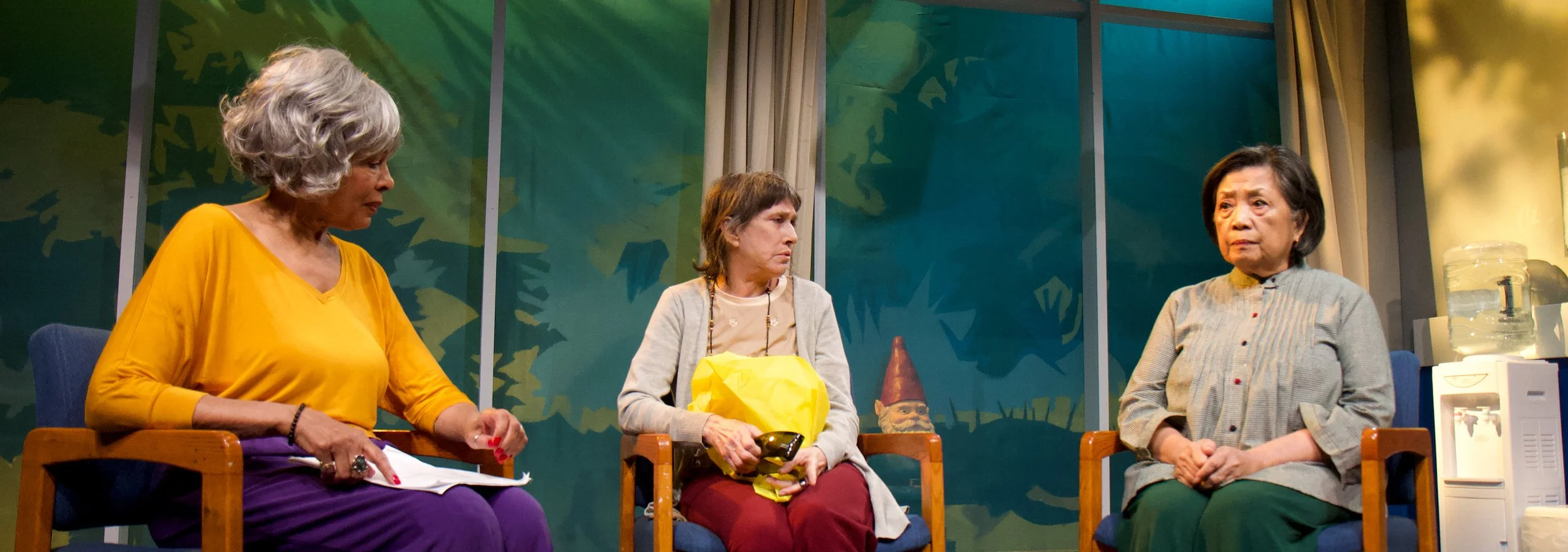There are lots of holes in Suzan-Lori Parks' The Book of Grace. One of them is the ominous open grave which one character digs in his backyard to deter another from rebelling. The other holes, unfortunately, are in the script, resulting in a production which is unsatisfying at its best. At its worst, it is downright dull. The play opens with a self-consciously poetic prologue introducing The Book of Grace's players: Vet (John Doman), an order-obsessed border guard; his battered wife, Grace (Elizabeth Marvel), who insists on seeing “evidence of good things” in her bleak and circumscribed life; and Buddy (Amari Cheatom), Vet's angry twenty-something son from an earlier marriage, who plans to give his abusive father three chances to redeem himself or he will take vengeance. A play about these three characters could have been explosive. Unfortunately, Parks never develops her characters beyond the cardboard archetypes of authoritarian father, self-deceived wife, and angry young man.
The Book of Grace takes it title from a collection of secret writings created by the title character to record all the good things that happen in the world around her. Determined to see the best in everything and blind to the flaws of her husband and stepson, Grace brings Vet and Buddy together again after a fifteen year estrangement. Hints of past sexual and physical abuse taint the father-son relationship as Vet dangles the possibility of a job and a promising future in front of his son.
The Book of Grace tries to be a metaphor for the dysfunctional attitudes which are at the core of contemporary American society. Its effectiveness is blunted, however, both by heavy-handed characterizations and by the uneven text. Parks seems to have discovered her characters as she wrote, taking up and discarding multiple threads without fully exploring them. With one dramatic and effective kiss, Buddy exposes his father's past sexual abuse. Soon after, however, this theme is forgotten and another shocking scene ensues. Grace and Buddy, who haven't seen each other since they were twenty and ten years old, inexplicably have sex within moments of their reunion. Later, Buddy develops an intense identification with home-grown terrorists such as Timothy McVeigh. Sure, there is some suggestion that Buddy had been “trouble” as a child, but other than a few broad hints here and there about the characters' pasts, no explanation is given for the characters' baffling and changeable behavior. All these flaws are compounded by a sudden and incomprehensible ending.
In a way, it is a shame that The Book of Grace is as much or more about Buddy as it is about the title character. While Buddy is never consistent enough to seem real, Marvel imbues Grace with a genuine sense of tragedy. In some ways, Grace is reminiscent of Mae in Maria Irene Fornes' 1983 play Mud. Small towns (and big cities) are full of Graces; good-hearted but cowed by husbands and brothers, they try to find some means of self-expression, be it via a night course or poorly written but earnest prose that they dream will become a bestseller. When Grace finally stands up for herself, the moment is electric.
Director James Macdonald is helped by solid performances from all three of his actors, who do the best that they can with the material they have been given. Macdonald comes up with some memorable bits of staging which capture the ambiguity and violence which lies beneath the surface of family relationships. At one point, Vet seems ready to greet his prodigal son with a hug but it swiftly turns into a pat-down. At another, Vet interprets one of Buddy's gestures as a victory “V” to celebrate the medal that Vet is about to receive. In fact, Buddy is indicating that his father has only one more strike to go before he will take revenge. Aside from a few moments, though, Grace generates surprisingly little tension.
Susan Hilferty's costumes are straightforward: Vet's impeccably creased uniform, Grace's pink waitress outfit, and Buddy's neutral jeans-and-undershirt ensemble each hint at the nature of their characters. Hilferty's only misstep is a red dress which Grace longs to have; although the dress is built up in earlier scenes, when it finally appears, it is too bland to reveal anything about Grace's interior life.
The scenic design by Eugene Lee is a metaphor for a crumbling American family. Detritus of other family dramas—a couch, a television set, an ironing board, and a kitchen sink—sit uncomfortably on a dirt floor. A encircling wooden path represents the outside world while upstage, a shovel and a pile of sandbags scattered with red sand lay beneath a huge highway billboard. The desolate landscape works both on a literal and a metaphorical level. With the addition of atmospheric lights by Jean Kalman and sound by Dan Moses Schreier (who provides a porn soundtrack which reads disturbingly and evocatively like sobbing), Grace is lovely both to see and to hear.
Unfortunately, a strong design and a few strong scenes are not enough to save The Book of Grace, a disappointing effort from a talented author.






